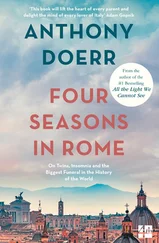The work of art.
It is just as fantastic now as it was then, Titus realises. A man is half-kneeling in front of a marble plinth on a brown floor. You can’t see his facial expression because it is shaded by a peak cap with a peak that must be more than one metre long. The peak hangs over the whole of the left side of the picture and rests on a crutch so as not to droop. The man has turned his side and most of his back to Titus. On a marble plinth between the crutch and the man there is a little clock that is sort of melting towards the man. Or is it time that is oozing from him? It’s hard to say. On the foot closest to Titus, the man has a grotesque sandal and large knotted toes. On the further leg, which is kneeling on the ground, he has a grey-black sock with a tight garter round his leg just beneath the knee. He is not wearing underpants. His shirt hangs down like a heavy long scrotum between his legs. His further bottom-half is far too long. It is enormously long! That too is supported on a crutch, almost at the very far right-hand side of the picture. It is inconceivable (at least for Titus) that the bottom could represent anything other than a giant penis. Does it need help to be able to support its weight, or to retain its stiffness? Whatever, the bottom-cum-penis sticks out about half a metre from the crutch like a glans inside foreskin without an opening. Gosh, what happens if he has to pee? Titus wonders. On the extended buttock, between the actual crack in his bottom and the crutch, hangs a bloody steak. And on one of the man’s sleeves there is another sort of beef steak, a sort of tennis-ball steak with a lid. Like a secretive meat cream bun, Titus thinks. The man’s other sleeve is just a sharp cone, a shirt spear which points backwards, into the black background of the picture. Under the bottom-cum-penis and the beef steak, some sweet little birds are pecking at the brown floor. Are they licking up the drops of blood from the beef, do you think? Meat-eating birds?
Titus has felt an affinity with Dali ever since that first acquaintance. As an artist, you can hardly be more obsessed than Dali. Dali knew what was what. Better to be obsessed than dependent. Me and Salvador, we are kindred spirits, Titus thinks. I must be just as merciless towards the surrounding world as he was. The world’s best painting must be related to The Best Book in the World.
Suddenly, Titus is surrounded by a group of schoolchildren who look about ten to twelve years old, together with a female museum guide in her thirties. You can see from far off that this is a guide who takes her job seriously. She touches the children and bends down to them when they ask questions. And most important of all: she laughs and smiles at their eyes.
‘This, dear children, this is The Enigma of Wilhelm Tell. An enigma means a mystery. This is one of the most famous paintings in the museum, a painting that actually contains lots of paintings and stories. It was painted in 1933 by a Spanish artist called Salvador Dali. What do you think about when you see this painting?’
‘He’s got his prick on his back!’ a boy calls out.
‘Yes… perhaps… what else do you think?’
‘He’s spooky,’ says a girl who giggles, slightly embarrassed.
‘I think he’s funny!’
Several children think the same. They giggle, laugh and shout ‘yuck’ and ‘urgh how horrid’ in turn. But they are without doubt more amused than worried.
‘What is it meant to be?’ another girl asks.
‘There is no simple answer,’ says the guide. ‘Shall I tell you a little about it?’
‘Yeees!’ all shout.
‘One of Salvador Dali’s aims with his life was to become a living legend. A celeb. For example, he twisted his moustaches so that they reached all the way out here,’ says the guide and shows with her fingers how they stretched across the cheeks. ‘This is how he started his autobiography: “When I was six years old I wanted to be a chef. When I was seven I wanted to be Napoleon. And, since then, my ambition has grown all the time.” That was quite something, wasn’t it?’
‘Who was Napoleon?’ a thin voice calls out from the very back of the group.
‘He was the emperor of France. A warrior who conquered lots of countries which he wanted to make part of France.’
‘Was Salvador a warrior too?’
‘No, he was an artist. But he was just as mad as Napoleon, perhaps. Shall I tell you about The Enigma of Wilhelm Tell? ’
‘Yeees!’
‘Well, Salvador Dali wanted people to be able to interpret his paintings in lots of different ways. His paintings could include almost anything: reality and things which only happen in dreams. There was room for it all. So this is what I think: this man in the painting can be all the gods, fathers and sons in the world, in one and the same person. The whole of mankind perhaps. And all the dreadful oppression in the world too. You can see how mutilated and imprisoned he is. He is stuck there, he is bent, you can’t see his face, and so on. Yes, he is dreadfully oppressed. Probably the painting is also about when dads treat their sons badly, because Salvador’s dad was almost always horrid to Salvador. Although he was a bit proud that Salvador was clever at drawing, he always thought that Salvador was silly and weird. He questioned everything that Salvador did, from what Salvador wanted to work with to what he was like as a lover. That alone should be enough for a whole life as an artist! Don’t you think?’
The children don’t really know what a lover does. Nor do they know what is necessary to be an artist. And round about now, the guide loses contact with the children for a few moments. What started as an exciting story soon gets lost in psychological explanations and incomprehensible references to Freud, Schiller and Nietzsche. She slowly notices that the children have dropped out, realises her mistake and gets back in line.
‘…but the people who have studied which things influenced Dali during this period say that The Enigma is also about political oppression and class conflicts. Workers and peasants against the growing middle class. There was a lot of anger in the world too. Do you think Salvador was an angry uncle?’
Some children nod. What else can they do? The group starts to break up at the edges and some kids sneak away to explore the surroundings on their own. A girl who is leaning against the wall looks dead. Suddenly she shows signs of life by blowing a big bubble with her chewing gum. Pop! The bubble bursts, and she is once again as stiff as a corpse. But the guide continues unabashed:
‘As I said, Salvador Dali had decided already when he was young that he would become a myth. An extremely complicated and totally fantastic myth that the world would never forget. He even lived in his own museum with giant eggs on the roof. He would NEVER be satisfied with a painting unless it had lots of different levels. Now listen to this: in Dali’s family there were several people who had suffered from mental illness – paranoia, schizophrenia, manic depression, indeed the whole works. But nobody was allowed to talk about it. So Salvador decided to both live and paint those behaviours that were forbidden. For example: when Salvador was going to ask Gala to marry him, he smeared himself with goat poop so that she wouldn’t choose him just because of his appearance! And she actually said yes.’
That saved the situation for the guide. Now the children wake up again, the few who are left. Poop works in every case and some of the kids even start to laugh out loud. Titus observes the spectacle with increasing amazement. The guide feels the wind in her sails and throws in more:
‘But his marriage became extremely weird even though they always loved each other. Perhaps Salvador’s dad was right when he said that his son was a rotten lover. It was said that his wife, Gala, who had a house in a little fishing village on the Costa Brava, welcomed the fishermen when they came home every day after their day’s fishing. She made love to them all, wildly and beautifully, every day. She was a nymphomaniac of grand proportions. Do any of you know what a nymphomaniac is?’
Читать дальше












